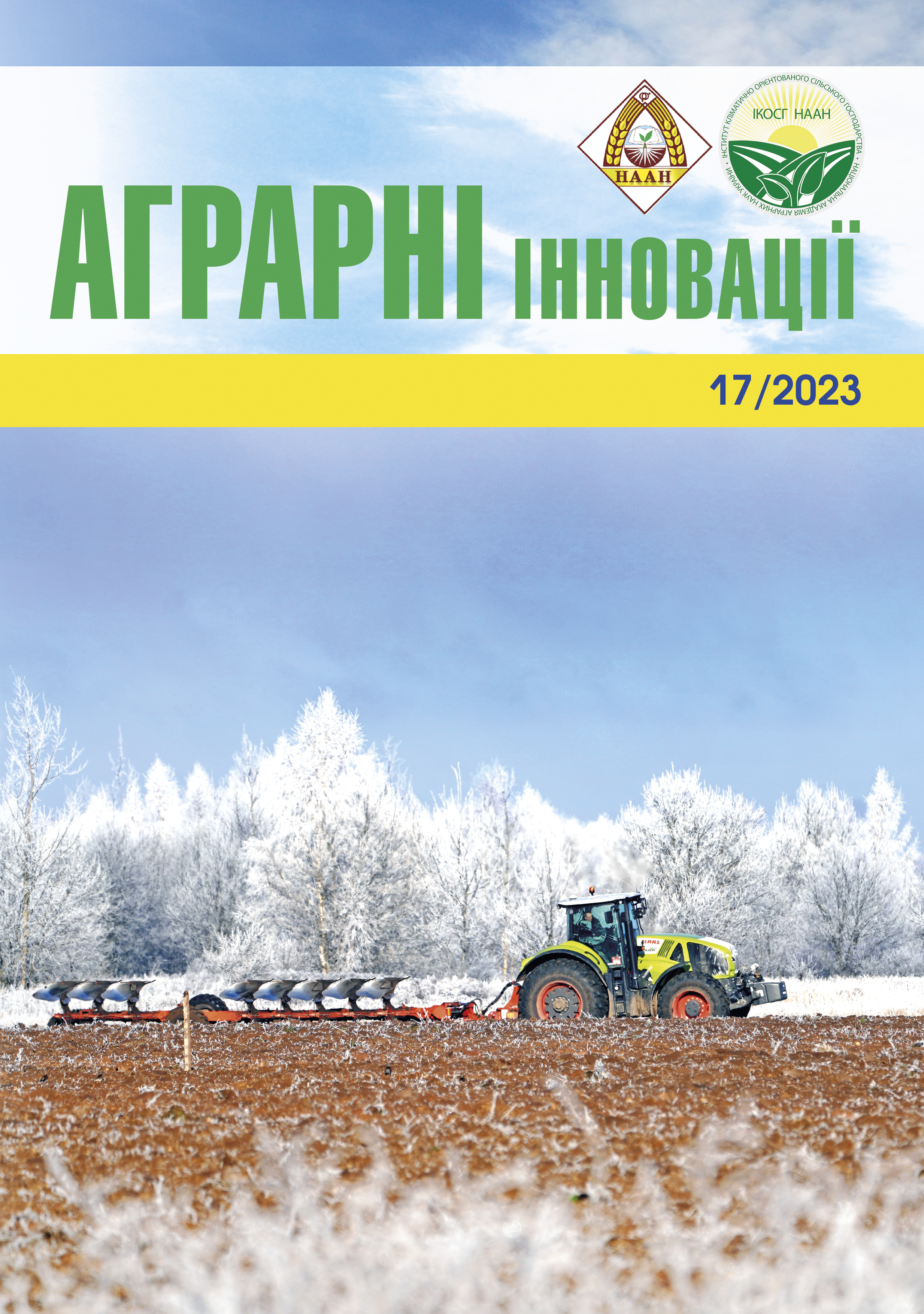MATHEMATICAL AND STATISTICAL ANALYSIS OF THE WORLD PRACTICE OF MINERAL FERTILIZERS APPLICATION IN THE PEPPERMINT CROPS
Abstract
Purpose. Peppermint is one of the most important medicinal and aromatic crops in Ukraine and in the world, therefore, it is important to study the peculiarities of its productivity formation. The article presents the results of mathematical analysis of mineral NPK fertilizers use efficiency in the crops of peppermint from the fresh biomass yielding capacity point of view. Methods. The generalized results of scientific research, conducted in different areas of the planet, were processed using the methods of multiple regression analysis to create the model of the crop’s yield depending on the doses of NPK fertilizers, as well as to approximate the results of modeling. Heteroscedasticity of the inputs of the model was additionally evaluated, as well as rank correlations assessment was done. Results. As a result of statistical computations, the most criteria attributed to data distribution normality and heteroscedasticity testify that the null hypothesis about the influence of mineral fertilizers on the yields of peppermint is denied. Rank correlation coefficients allows to state that phosphorus fertilizers are of the greatest impact on the crop’s productivity, while potassium fertilizers play the minimum role, and in some cases, it could be neglected as insignificant. Multiple regression model of the yields of peppermint depending on the doses of NPK mineral fertilizers application has average fitting quality with low prognostic value. Regression coefficients within the rank correlation also support the leading role of phosphorus fertilizers in the formation of peppermint productivity. Conclusions. Thus, further in-field and in-pot investigations with nitrogen-phosphorus fertilizers are prospective to enhance the knowledge on peppermint productivity formation, whereas potassium fertilizers are highly likely to have almost no impact on the crop’s yields and economic efficiency of its raw material production.
References
2. Sujana P., Sridhar T. M., Josthna P., Naidu C. V. Antibacterial activity and phytochemical analysis of Mentha piperita L. (Peppermint) – An important multipurpose medicinal plant. American Journal of Plant Sciences. 2013. Vol. 4. P. 77–83. DOI:10.4236/ ajps.2013.41012
3. Yamamoto N., Nakai Y., Sasahira N., Hirano K., Tsujino T., Isayama H., Komatsu Y., Tada M., Yoshida H., Kawabe T., Hiki N., Kaminishi M., Kurosaka H., Omata M. Efficacy of peppermint oil as an antispasmodic during endoscopic retrograde cholangiopancreatography. Journal of Gastroenterology and Hepatology. 2006. Vol. 21. P. 1394–1398.
4. Cash B., Epstein M., Shah S. A novel delivery system of peppermint oil is an effective therapy for irritable bowel syndrome symptoms. Digestive Diseases and Sciences. 2016. Vol. 61. P. 560–571. DOI: 10.1007/ s10620-015-3858-7
5. Haber S. L., El-Ibiary S. Y. Peppermint oil. American Journal of Health-System Pharmacy. 2016. Vol. 73. P. 22–26. DOI:10.2146/ajhp140801
6. Cunha A. P., Ribeiro J. A., Roque O. R. Plantas aromáticas em Portugal. Caracterização e utilização. Lisboa : Fundação Calouste Gulbenkian. 2007.
7. Arrobas M., Ferreira I. Q., Afonso S., Ângelo Rodrigues M. Sufficiency ranges and crop nutrient removals for peppermint (Mentha X piperita L.) established from field and pot fertilizer experiments. Communications in Soil Science and Plant Analysis. 2018. 12 pp. DOI: 10.1080/00103624.2018.1474909
8. Jeliazkova E. A., Zheljazkov V. D., Craker L. E., Yankov B., Georgieva T. NPK fertilizers and yields of peppermint, Mentha x Piperita. Acta Horticulturae. 1999. 502. P. 231–236.
9. Patrui O., Tabara V. Research on the quality yield of herbal mint (Mentha piperita L.) under the influence of mineral and organic fertilization in climate conditions in S. C. D. A. Lorvin. Buletinul AGIR. 2011. No. 2. P. 60–62.
10. Tepecik M., Esetlili B. C., Ozturk B., Anac D. Effect of different fertilizers on peppermint – Essential and nonessential nutrients, essential oils and yield. Italian Journal of Agronomy. 2022. Vol. 17. 1921. DOI: 10.4081/ija.2022.1921
11. Can M., Katar D. Effect of different nitrogen doses on agricultural and quality characteristics of Mentha x piperita L. and Mentha spicata L. species. Journal of Agricultural Science and technology. 2021. Vol. 23. No. 6. P. 1327–1338.
12. Cerven, V. Effect of nitrogen, location, and harvesting stage on peppermint (Mentha X piperita L.) productivity, oil content, and composition. A thesis for the degree of Master of Science. Mississippi State, US. 2009. 50 pp.
13. Jat, M., Singh, G., Choudhary, S. Standardizing drip irrigation scheduling and NPK levels on economics and energy use of Mentha ( Mentha arvensis) Crop in Tarai regions of Uttarakhand. International Journal of Environment and Climate Change. 2023. Vol. 13. No. 3. P. 125–133.
14. Behera, M. S., Mahapatra, P. K., Singandhupe, R. B., Kundum D. K., Kannan, K., Mandal, K. G., Singh, A. Effect of drip fertigation on yield, water use efficiency and water productivity of mint (Mentha arvensis L.). Journal of Agricultural Physics. 2014. Vol. 14. No. 1. P. 37–43.
15. Krämer, W., Sonnberger, H. The linear regression model under test. Springer Science & Business Media, 2012.
16. White, H. A heteroskedasticity-consistent covariance matrix estimator and a direct test for heteroskedasticity. Econometrica: Journal of the Econometric Society. 1980. P. 817–838.
17. Cureton, E. E. Rank-biserial correlation. Psychometrika. 1956. Vol. 21. P. 287–290. DOI: 10.1007/BF02289138
18. Forthofer, R. N., Lehnen, R. G., Forthofer, R. N., Lehnen, R. G. Rank correlation methods. In Public Program Analysis: A New Categorical Data Approach. Springer, 1981. P. 146-163. DOI: 10.1007/978-1-4684-6683-6_9
19. Haase, R. F. Multivariate General Linear Models. Sage, 2011.
20. Blasco B. C., Moreno J. J. M., Pol A. P., Abad A. S. Using the R-MAPE index as a resistant measure of forecast accuracy. Psicothema. 2013. Vol. 25. No. 4. P. 500–506. DOI: 10.7334/psicothema2013.23






